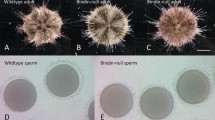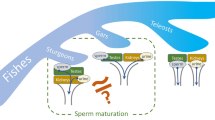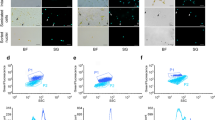Abstract
A SEARCH of the literature reveals no report of the comparative base composition of deoxyribonucleic acids isolated from the two gametes and the somatic cells of the same species. Yet the molecular events whereby genetic information from egg and sperm is integrated on fertilization are of fundamental importance in our understanding of the molecular basis of heredity and development in higher animals. These facts prompted the work recorded here, which is concerned with properties of the DNA isolated from sperm, eggs and adult somatic cells of the sea urchin Arbacia punctulata. Sperm and eggs were obtained either by the mild electric shock technique of Harvey1 or by the injection of 0.5 M KCl2 into the perivisceral cavity of adult sea urchins. The diploid tissues were obtained from spent adults, the gonads of which were discarded. The DNA from sperm and diploid tissues was isolated by a modification of the procedure described by Marmur3. High-molecular-weight DNA from eggs could not be prepared in this way unless the nuclei were first isolated by the method of Went and Mazia4. The hot phenol method5 was also effective in the isolation of DNA from whole eggs. Failure to isolate egg DNA by mild procedures might be due to the presence of potent deoxyribonucleases, which in turn could account for the inability of some investigators6 to obtain highly polymeric DNA from this source.
This is a preview of subscription content, access via your institution
Access options
Subscribe to this journal
Receive 51 print issues and online access
$199.00 per year
only $3.90 per issue
Buy this article
- Purchase on Springer Link
- Instant access to full article PDF
Prices may be subject to local taxes which are calculated during checkout
Similar content being viewed by others
References
Harvey, E. B., The American Arbacia and other Sea Urchins (Princeton University Press, 1956).
Tyler, A., Coll. Net., 19, 19 (1949).
Marmur, J., J. Mol. Biol., 3, 208 (1961).
Went, H. A., and Mazia, D., Exp. Cell Res., Supp. 7, 200 (1959).
Wecker, E., Virology, 7, 241 (1959).
Comb, D. G., and Brown, R., Exp. Cell Res., 34, 360 (1964). See also Marshak, A., and Marshak, C., Nature, 174, 919 (1954); Biochim. Biophys. Acta, 15, 585 (1954).
Doty, P., Marmur, J., Eigner, J., and Schildkraut, C., Proc. U.S. Nat. Acad. Sci., 46, 761 (1960).
Schildkraut, C. L., Marmur, J., and Doty, P., J. Mol. Biol., 4, 430 (1962).
Vendrely, R., in Nucleic Acids, edit. by Chargaff and Davidson, 2, 155 (Academic Press Inc., New York, 1955).
Rosenkranz, H. S. (unpublished results).
Schurin, M., and Marmur, J., Abst. Papers First Ann. Meet. Amer. Soc. Cell Biol., 193 (1961).
Author information
Authors and Affiliations
Rights and permissions
About this article
Cite this article
GARDEN, G., ROSENKRANZ, S. & ROSENKRANZ, H. Deoxyribonucleic Acids of Sperm, Eggs and Somatic Cells of the Sea Urchin, Arbacia punctulata. Nature 205, 1338–1339 (1965). https://doi.org/10.1038/2051338a0
Issue Date:
DOI: https://doi.org/10.1038/2051338a0
This article is cited by
-
Morphologische und biochemische Charakterisierung der Entwicklung befruchteter Eier des SeeigelsSphaerechinus granularis Lam
Wilhelm Roux' Archiv f�r Entwicklungsmechanik der Organismen (1974)
-
Protein Synthesis in the Absence of the Nucleus
Nature (1967)
-
DNA during the Development of the American Sea Urchin
Nature (1967)
-
Circular DNA from sand dollar sperm
Naturwissenschaften (1967)
Comments
By submitting a comment you agree to abide by our Terms and Community Guidelines. If you find something abusive or that does not comply with our terms or guidelines please flag it as inappropriate.



